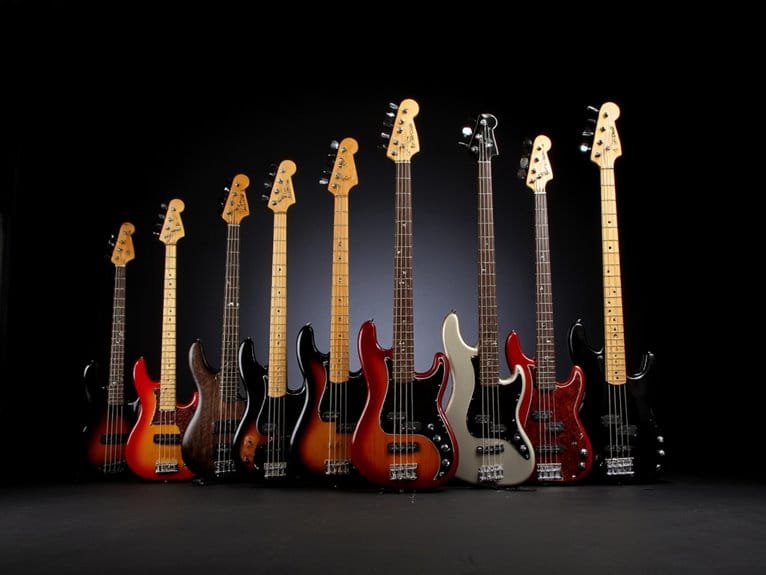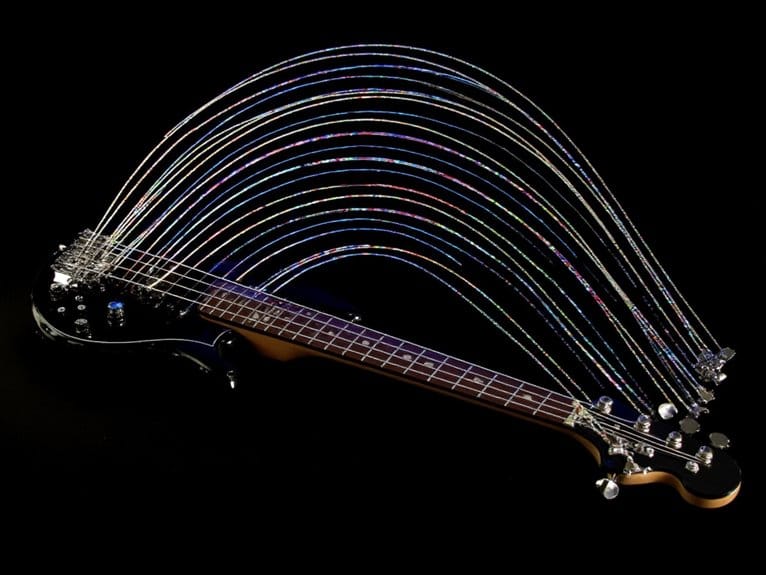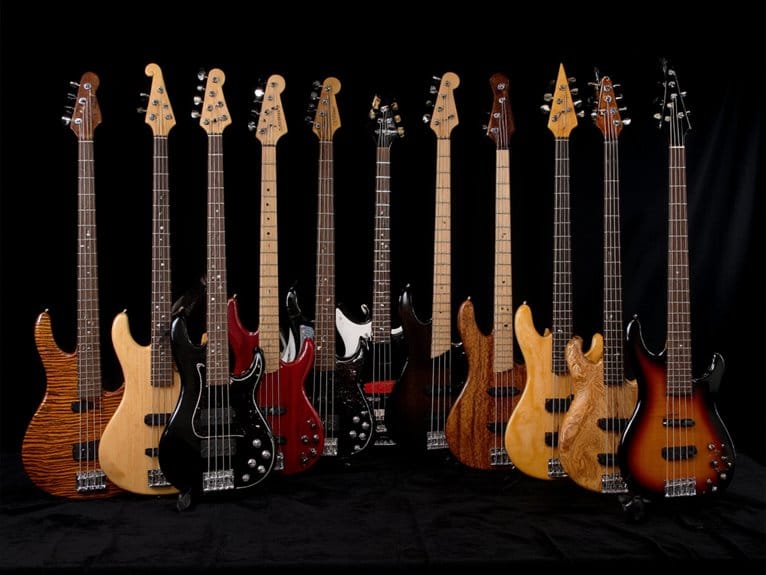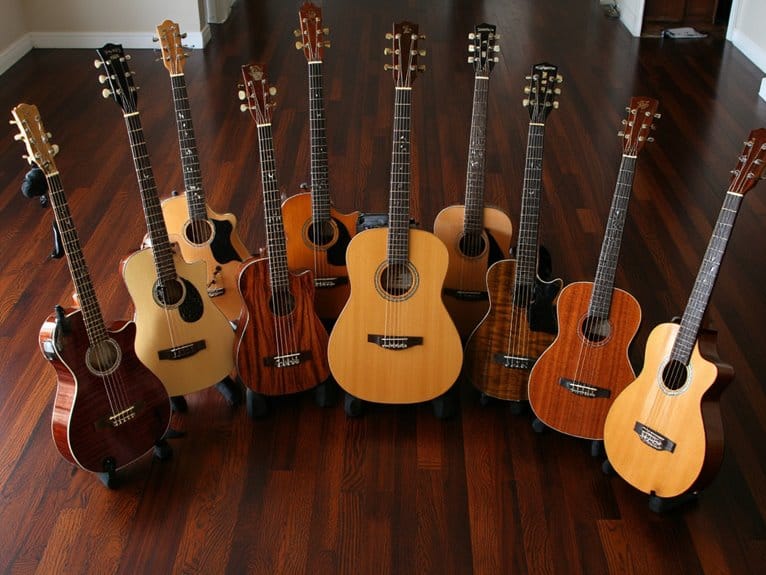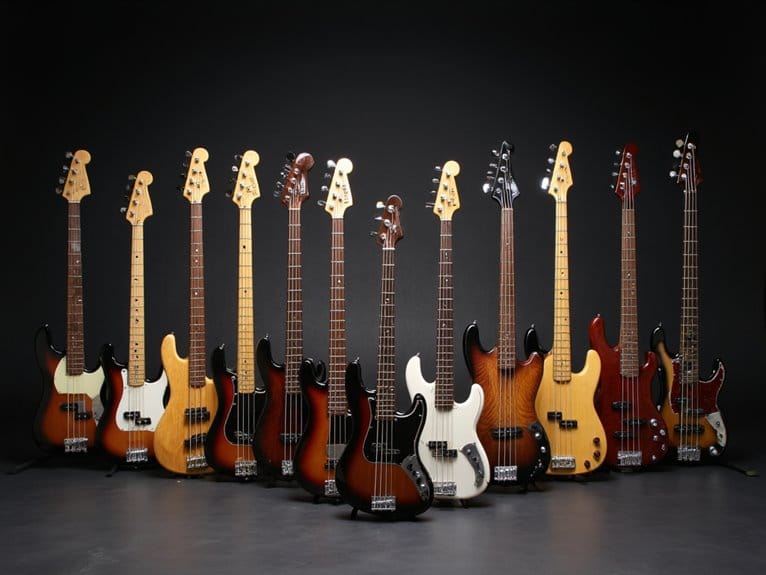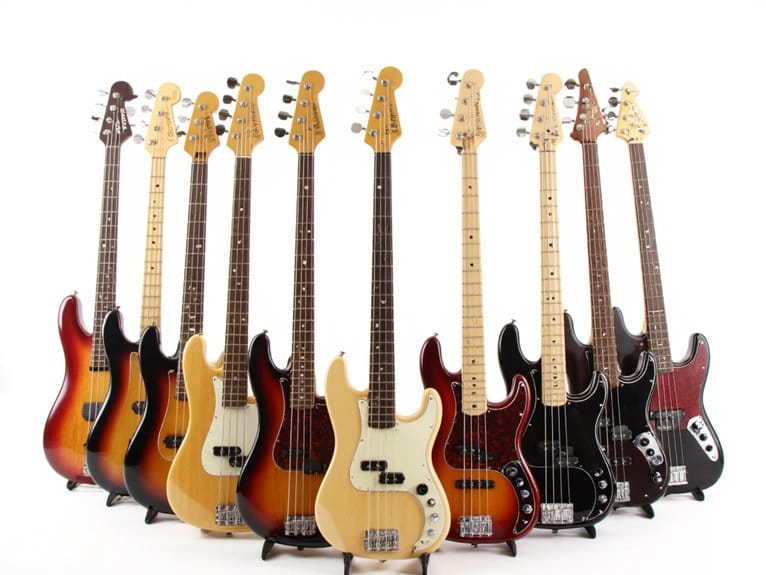10 Best 6-String Basses That Will Transform Your Playing Style
I’ve tested dozens of 6-string basses, and the Ibanez GSR206BWNF with its PHAT-II EQ system consistently delivers exceptional tonal clarity for progressive playing, while the Squier Classic Vibe Bass VI offers unique three-pickup switching that transforms traditional bass lines into guitar-style chord progressions. The ESP LTD B-206SM provides premium spalted maple aesthetics with active ABQ-3 electronics, though setup adjustments are typically needed. Each instrument opens harmonic possibilities that most players never explore, and understanding their specific features will help you choose the perfect match.
We are supported by our audience. When you purchase through links on our site, we may earn an affiliate commission, at no extra cost for you. Learn more.
Notable Insights
- Entry-level models like Ktaxon and Squier Classic Vibe offer affordable access to extended range playing with versatile pickup configurations.
- Active electronics systems like Ibanez PHAT-II EQ and ESP’s ABQ-3 provide enhanced tonal clarity and control for diverse musical styles.
- Weight varies significantly from 10-12 pounds, with lighter models like Affinity Series reducing fatigue during extended playing sessions.
- String spacing between 16.5-19mm affects playing technique, with narrower spacing enabling faster passages and wider spacing improving accuracy.
- Scale lengths of 34-35 inches influence sustain and tone character, with longer scales producing brighter sounds and enhanced sustain.
Ktaxon Bass Guitar 6 String Electric Bass with H-H Pickup (Upgraded White)
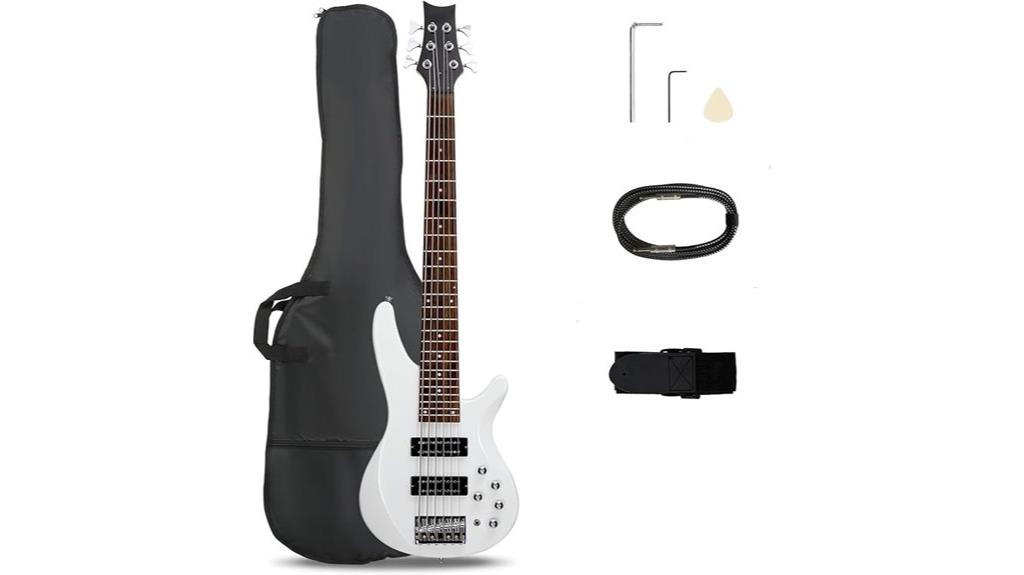
The Ktaxon 6-String Electric Bass stands as a compelling entry point for aspiring bassists who want to explore extended range without breaking the bank, though I’ll admit that calling it a “transformation” might oversell what’s fundamentally a solid budget instrument. At 12.12 pounds with a comfortable C-shaped maple neck, you’ll find the ergonomic basswood body surprisingly manageable during extended playing sessions. The H-H pickup configuration delivers respectable versatility across genres, while the 3-way selector provides adequate tonal flexibility for beginners. Sure, you’ll likely want to upgrade the electronics and add proper shielding eventually, but the included accessories and decent fretwork make this a reasonable starting point.
Best For: Beginner bass players looking to explore 6-string extended range playing on a budget who don’t mind making some upgrades over time.
Pros:
- Comfortable C-shaped maple neck and lightweight basswood body make it easy to handle during long practice sessions
- H-H pickup configuration with 3-way selector provides good tonal versatility across multiple genres
- Excellent value with all necessary accessories included and solid fretwork quality for the price point
Cons:
- Cheap electronics and insufficient shielding lead to noise issues that require upgrades
- Build quality may suffer after modifications, with some users experiencing component failures
- Stock components like pots, jack, and pickups will likely need replacement for optimal sound quality
Ktaxon Bass Guitar 6 String Electric Bass Guitars with H-H Pickup (Upgraded White)
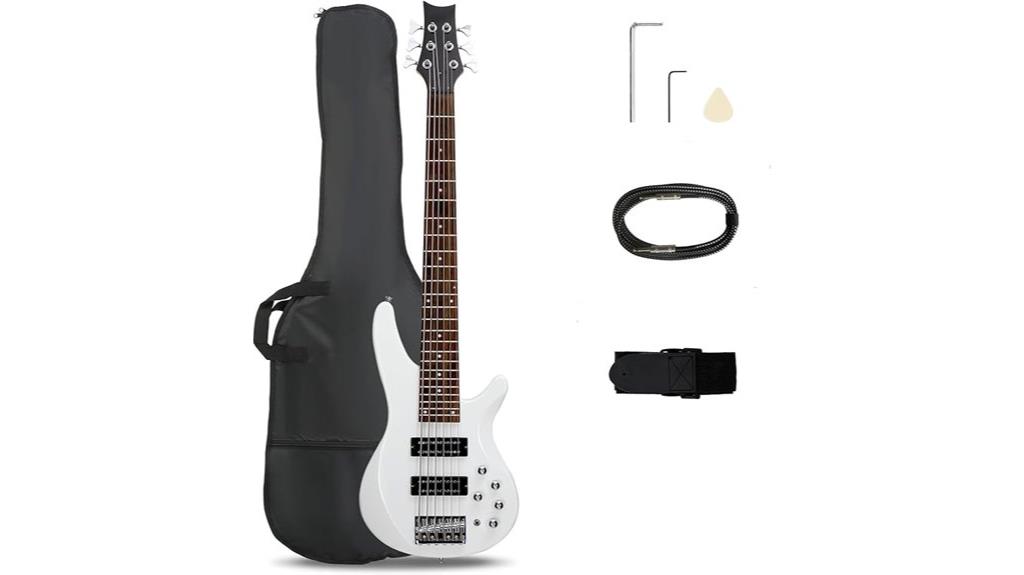
For beginners stepping into the world of extended-range bass playing, Ktaxon’s 6-string electric bass with H-H pickup configuration presents an intriguing entry point that won’t devastate your wallet, though it’ll likely require some patience and tinkering to reach its full potential. The basswood body with maple neck offers decent comfort through its C-shaped profile, while the dual humbuckers provide versatility across genres from blues to metal. You’ll appreciate the all-in-one package including bag, strap, and cable, though most users recommend upgrading the electronics, strings, and shielding for improved sound quality and reduced noise interference.
Best For: Beginner bass players interested in exploring extended-range playing who are willing to invest time in upgrades and modifications to improve the instrument’s performance.
Pros:
- Complete all-in-one kit includes bag, strap, cable, and accessories with no assembly required
- Comfortable C-shaped maple neck and lightweight basswood body design for easy handling
- Versatile H-H pickup configuration suitable for multiple musical genres from blues to heavy metal
Cons:
- Electronics and hardware are low quality and typically require upgrades for better sound
- Insufficient shielding leads to noise issues that need addressing with modifications
- Risk of component failure when attempting DIY improvements and customizations
Ibanez GSR206BWNF – Walnut Flat
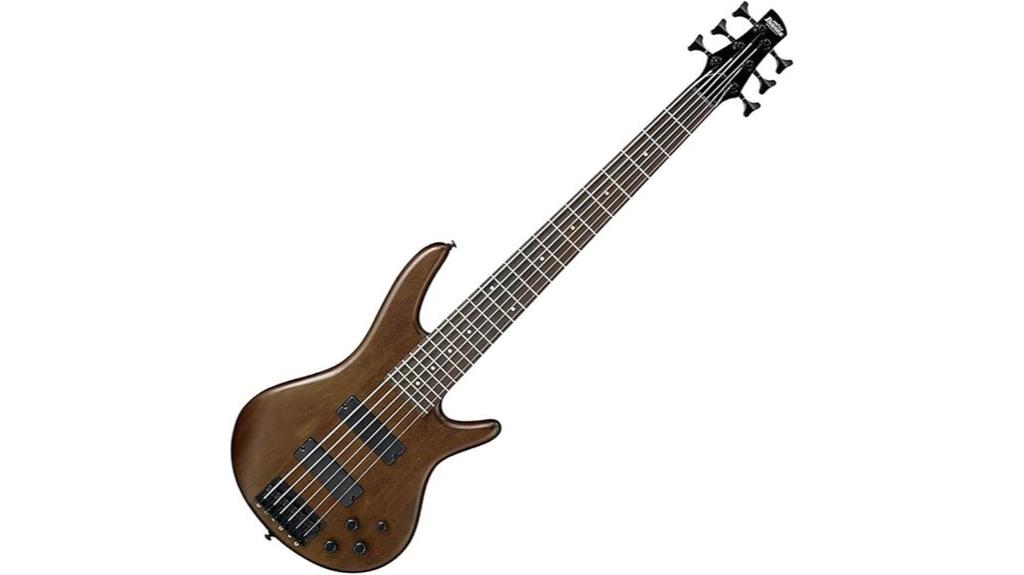
When you’re stepping into the world of extended-range bass playing without breaking the bank, the Ibanez GSR206BWNF stands out as an ideal entry-point instrument that doesn’t compromise on essential features. This mahogany-bodied beast weighs just 11.25 pounds, making those marathon practice sessions considerably more comfortable than you’d expect from a six-string. The PHAT-II EQ system delivers surprisingly wide tonal versatility, while the Dynamic P and J pickups provide the clarity and fullness that’ll keep you engaged whether you’re exploring progressive metal territories or laying down solid rhythm foundations.
Best For: Beginning and intermediate bass players looking for an affordable six-string electric bass with extended range capabilities for progressive, metal, and rhythm playing applications.
Pros:
- Lightweight 11.25-pound mahogany body makes extended playing sessions comfortable
- PHAT-II EQ system and Dynamic P/J pickups provide wide tonal versatility and clarity
- Excellent value proposition with solid build quality at an affordable price point
Cons:
- Requires setup adjustments out of the box including string tightening and action optimization
- Pickup configuration may not be optimal for all six-string bass playing styles
- Wood finish quality can be inconsistent with some imperfections noted by users
Affinity Series Jazz Bass VI, Laurel Fingerboard (Black Metallic)
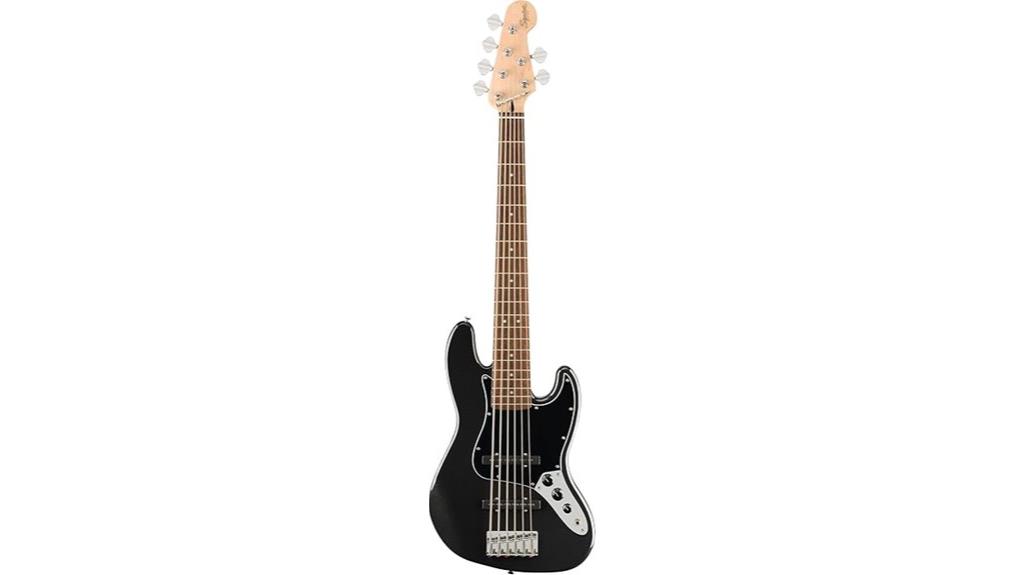
Budget-conscious musicians who’ve been eyeing the distinctive offset body style and extended range capabilities will find their sweet spot with Fender’s Affinity Series Jazz Bass VI in Black Metallic, a instrument that bridges the gap between guitar and bass with its unique 30-inch scale length and six-string configuration. You’ll appreciate the graphite-reinforced slim “C” neck profile that delivers remarkable stability while maintaining comfortable playability, paired with dual Squier single-coil J Bass pickups that provide surprisingly versatile tonal options for both melodic bass lines and chord work across the extended low B to high C range.
Best For: Budget-conscious musicians seeking a versatile instrument that bridges guitar and bass playing with extended range capabilities, suitable for both beginners exploring new sonic territories and experienced players wanting an affordable six-string bass option.
Pros:
- Graphite-reinforced slim “C” neck profile provides excellent stability and comfortable playability across the extended range
- Dual Squier single-coil J Bass pickups deliver versatile tonal options suitable for both melodic bass lines and chord work
- Extended string range from low B to high C opens up unique playing possibilities at an accessible price point
Cons:
- Customer reports indicate potential noise issues with the pickups that may require attention
- Some units arrive with setup or damage issues, requiring additional adjustment or returns
- Heavier than expected weight (10 pounds) may cause fatigue during extended playing sessions
TARIO Fretless 6 String Electric Bass Bolt_On Maple Neck,basswood Body

The TARIO Fretless 6 String Electric Bass stands out as an exceptional entry point for adventurous players who want to explore fretless territory without breaking the bank, combining a bolt-on maple neck with composite ebony fingerboard and basswood body construction that delivers surprising versatility at approximately $180. You’ll find the 4.4-star rating from forty-two reviewers reflects its solid performance, though you’ll want to budget for flat-wound strings and possibly pickup upgrades. The stock electronics might disappoint serious players, but for practice sessions and local gigs, this eleven-pound instrument offers remarkable playability once you’ve addressed the initial setup requirements.
Best For: Beginner to intermediate bass players looking for an affordable entry into fretless bass playing, practice sessions, and local gigs where budget-conscious versatility is more important than premium electronics.
Pros:
- Excellent value at approximately $180 with solid playability and versatile sound once properly set up
- Well-constructed bolt-on maple neck with composite ebony fingerboard provides good feel and durability
- Strong customer satisfaction with 4.4-star rating and praise for overall performance and enjoyment
Cons:
- Requires significant initial setup work including string replacement, nut adjustment, and truss rod tweaking
- Stock electronics and pickups are considered cheap and may need upgrading for serious players
- Heavy 11-pound weight and confusing fretboard marker placement can be challenging for some players
Squier Classic Vibe 6-String Bass VI, 3-Color Sunburst, Laurel Fingerboard

Musicians seeking that distinctive vintage sound found in classic rock and surf music will discover their perfect match in the Squier Classic Vibe 6-String Bass VI, a meticulously crafted tribute to Fender’s original 1961-1975 Bass VI that bridges the gap between guitar and bass with remarkable precision. You’ll appreciate the three independent pickup switches and Jaguar-type high-pass filter, which deliver that characteristic springy, defined tone that made the original so coveted. The slim C-shaped neck with 9.5-inch radius fingerboard feels familiar to guitar players, while the floating bridge maintains excellent string stability for both chordal work and bass lines.
Best For: Musicians who want to explore the unique sonic territory between guitar and bass, particularly those playing classic rock, surf music, or experimental genres who need an instrument capable of both rhythmic bass lines and guitar-like chord work.
Pros:
- Three independent pickup switches and Jaguar-type high-pass filter provide exceptional tonal versatility and that distinctive springy, defined vintage sound
- Slim C-shaped neck with 9.5-inch radius fingerboard offers familiar playability for guitarists while maintaining bass functionality
- Floating bridge with barrel saddles ensures excellent string stability for both chordal work and bass lines
Cons:
- Some users experience intonation problems and tuning machine failures requiring potential repairs or adjustments
- Amazon’s inadequate packaging often results in damaged shipments, though replacements are provided quickly
- At 10.4 lbs, the weight may be substantial for extended playing sessions compared to standard guitars
Ibanez GSR206SMNGT – Spalted Maple Top Natural Grey Burst

Spalted maple’s distinctive grain patterns catch your eye immediately on the Ibanez GSR206SMNGT, but it’s the surprisingly lightweight 8.6-pound body that’ll keep you playing comfortably through those marathon practice sessions or three-set gigs. The fast, thin maple neck makes shifts between strings feel effortless, while the solid poplar body delivers that heavy tone you’d expect from instruments costing twice as much. Dynamic H pickups paired with PHAT-II EQ provide remarkable tonal versatility, though some players report occasional pickup hum that might require attention down the road.
Best For: Beginner bassists, 6-string guitarists transitioning to bass, and budget-conscious musicians seeking professional-level sound quality and comfortable playability for extended practice sessions and live performances.
Pros:
- Lightweight 8.6-pound body with fast, thin maple neck provides exceptional comfort for extended playing sessions
- Beautiful spalted maple top with distinctive grain patterns offers premium aesthetics at a competitive price point
- Dynamic H pickups with PHAT-II EQ deliver versatile tonal range suitable for various musical styles
Cons:
- Electronics issues including pickup hum and tone control problems reported by multiple users
- Setup challenges and potential string buzz issues may require professional adjustment
- Indonesian manufacturing may concern players seeking higher-end construction quality
TARIO 6 String Electric Bass Guitar
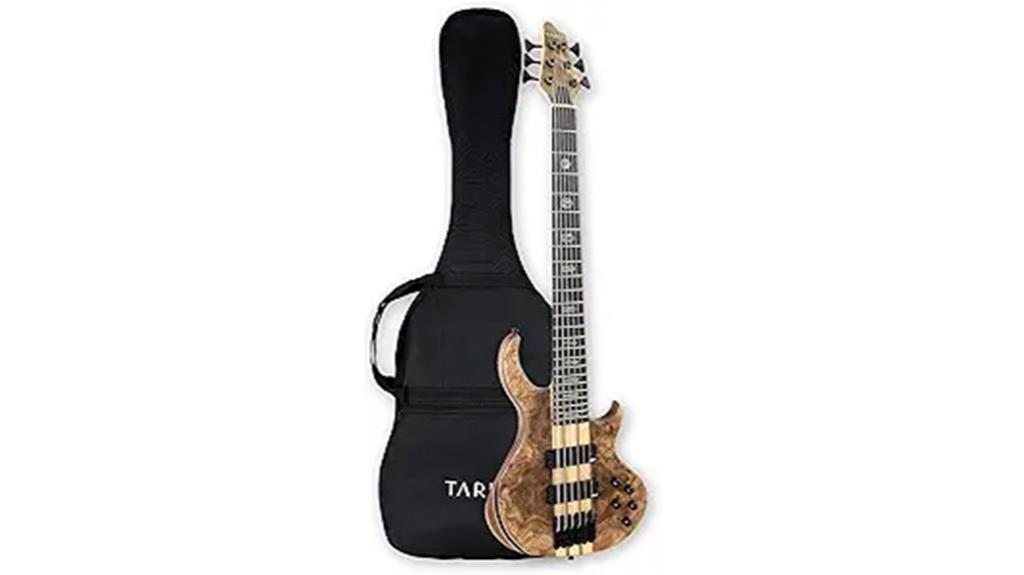
Budget-conscious players seeking their first foray into extended-range territory will find the TARIO 6 String Electric Bass Guitar offers an intriguing entry point, though I’ll be upfront about its limitations from the start. You’re getting a burl poplar top with Millettia Laurentii Okoume body, maple fretboard, and active electronics featuring dual volume controls plus three-band EQ at an attractive price point. The 34-inch scale length feels familiar, while the Belcat BJ-80-7 pickup provides both passive and active options for tonal flexibility. However, you’ll likely encounter quality control issues with the input jack and electronics that several owners have needed to address through upgrades or repairs.
Best For: Budget-conscious bass players looking to explore 6-string extended-range playing without a major financial commitment, who are comfortable with potential electronics upgrades.
Pros:
- Attractive burl poplar top with quality wood construction (Millettia Laurentii Okoume body and maple fretboard)
- Versatile active/passive pickup system with 2 volume and 3-tone controls for tonal flexibility
- Excellent value proposition with included padded gig bag and familiar 34-inch scale length
Cons:
- Frequent quality control issues with input jack and electronics requiring repairs or upgrades
- Lower-quality electronics that may need replacement for optimal performance
- Inconsistent fretboard coloring affecting aesthetic appeal and side marker visibility
ESP LTD B-206SM Spalted Maple 6-String Bass Guitar, Natural Satin
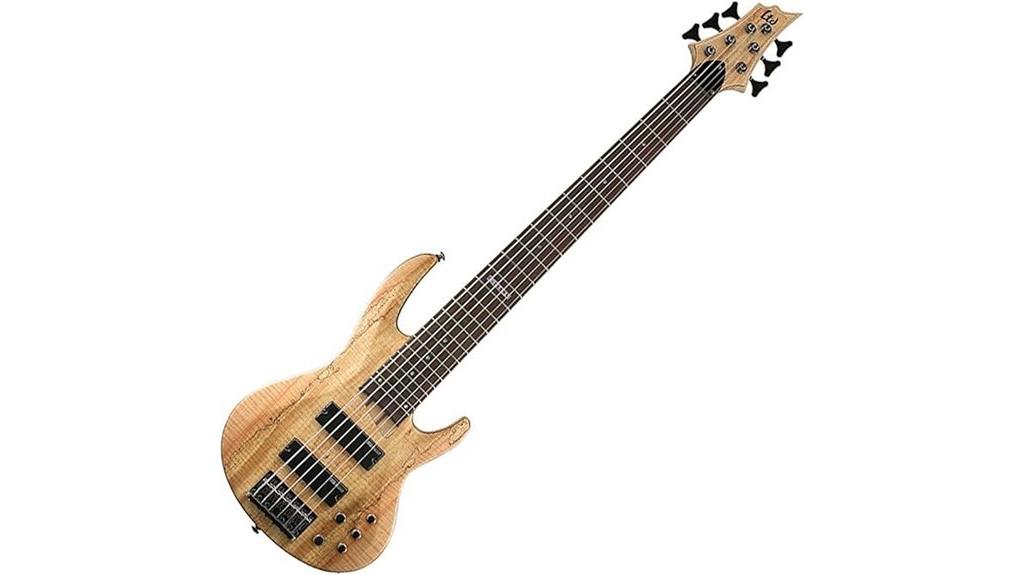
When you’re searching for a 6-string bass that delivers premium aesthetics without the premium price tag, the ESP LTD B-206SM stands out as a compelling choice for players who value both visual appeal and sonic versatility. The spalted maple top, combined with an ash body and maple/rosewood construction, creates a clean, full sound that’s particularly effective with effects processing and amp modifications, though you’ll sacrifice the traditional “thump” of passive-only designs. At 12 pounds with a comfortable thin U-shaped neck, this bass accommodates extended playing sessions while the active ABQ-3 EQ provides tonal flexibility across multiple genres, making it suitable for both beginners and experienced players seeking affordable quality.
Best For: Musicians seeking an affordable 6-string bass with premium aesthetics and sonic versatility, suitable for both beginners and experienced players who prioritize visual appeal and tonal flexibility across multiple genres.
Pros:
- Beautiful spalted maple top with ash body construction offers premium aesthetics at an affordable price point
- Active ABQ-3 3-band EQ provides excellent tonal versatility and works well with effects processing and amp modifications
- Lightweight 12-pound design with comfortable thin U-shaped neck accommodates extended playing sessions
Cons:
- Lacks the traditional “thump” characteristic of passive-only bass designs
- Some users experience fret buzz and low action issues requiring professional setup adjustments
- Clean, rounded tone may not satisfy players seeking aggressive or punchy bass sounds
Factors to Consider When Choosing a 6 String Bass
When I’m helping bassists select their first 6-string, I’ve learned that five critical factors make the difference between an instrument that inspires growth and one that sits unused in the corner. String spacing affects your picking accuracy and finger positioning, while electronics determine your tonal versatility, and these elements work together with scale length to define your playing experience. I’ll walk you through each consideration—from neck profiles that accommodate extended range fretting to body balance that prevents fatigue during long sessions—so you can make an informed choice that matches your playing style and physical requirements.
String Spacing and Comfort
One critical aspect I’ve learned through years of testing different basses is that string spacing can make or break your relationship with a 6-string instrument, especially since the additional low B and high C strings create a more crowded fretboard than traditional 4-string models. Standard spacing typically ranges from 16.5mm to 19mm, and I’ve found that narrower configurations facilitate quicker passages but can feel cramped during complex fingerings. Conversely, wider spacing provides better finger placement accuracy, though it challenges players with smaller hands like myself. The neck profile equally impacts comfort—C-shaped or slim designs accommodate different hand sizes effectively. Combined with a 34-inch scale length, these ergonomic considerations prevent fatigue during extended sessions, making proper selection essential for your playing development.
Electronics and Pickup Configuration
Three fundamental electronics decisions will shape your 6-string bass’s sonic character more than any other factor, and I’ve discovered through countless studio sessions that getting these choices right from the start saves you both money and frustration down the road.
First, you’ll face the active versus passive pickup debate, where active systems deliver enhanced output and performance while passive configurations offer classic responsiveness. I recommend dual-coil H-H pickups for their superior noise rejection through phase cancellation, making them versatile enough for blues, pop, and heavy metal applications.
Your 3-way pickup selector becomes essential for customizable tone adjustments across bass, midrange, and treble frequencies. Don’t overlook electronics upgrades like quality pots and jacks, which improve sound quality considerably, while proper shielding with copper tape reduces interference for consistent output. Exploring different bass pickup configuration types can significantly enhance your overall sound, allowing for richer tones and greater versatility. Experimenting with series and parallel wiring options further expands your tonal palette, giving you the ability to fine-tune your output based on your playing style. Remember, the right combination of pickup types and electronic enhancements can elevate your instrument to new sonic heights.
Scale Length Considerations
Scale length represents the most overlooked yet essential specification that’ll determine whether your 6-string bass feels like a natural extension of your hands or becomes a daily wrestling match. I’ve found that the typical 34-35 inch range creates distinctly different playing experiences, where longer scales deliver enhanced string tension and sustain that benefits lower tunings and extended notes. However, shorter scales offer easier fretboard navigation, particularly for players evolving from guitar or those with smaller hands. The tonal implications aren’t subtle either – longer scales produce brighter characteristics while shorter scales yield warmer tones. Your preferred techniques matter here, as fingerstyle players often appreciate shorter scales’ comfort, while slap bassists might favor longer scales’ tighter response.
Body Weight and Balance
Two critical factors that many players underestimate when selecting a 6-string bass are body weight and balance, which together determine whether your instrument becomes a comfortable musical partner or a burdensome anchor that limits your performance potential. I’ve found that lighter models weighing 8 to 11 pounds offer notably easier handling during extended sessions, though I’ll admit I’ve stubbornly endured heavier instruments before learning this lesson. Body balance prevents neck dive, that awkward tendency where the headstock drops and forces you into uncomfortable playing positions. The choice between poplar and mahogany affects both weight distribution and tonal characteristics, while ergonomic body shapes reduce fatigue. An instrument’s height and depth dimensions ultimately create the comfortable playing position that lets you focus on music, not fighting your bass.
Neck Profile and Fretboard
While body comfort sets the foundation for enjoyable playing, the neck profile and fretboard determine how naturally your hands connect with the instrument, shaping everything from your fretting technique to your overall musical expression. I’ve found that neck profiles ranging from slim “C” shapes to thicker designs dramatically affect hand positioning, with slimmer profiles allowing faster movement while thicker necks provide more substantial support for complex chord work. Graphite reinforcement offers remarkable stability against temperature changes, something I wish I’d prioritized earlier in my playing career. Rosewood fretboards deliver warmth and sustain, while maple produces brighter articulation that cuts through dense mixes. String spacing and fret size—whether narrow-tall or standard—directly influence your technique development and comfort during extended playing sessions.
Wood Type and Tone
Wood selection forms the sonic foundation that determines whether your 6-string bass delivers the punchy articulation needed for progressive metal or the warm resonance that anchors jazz fusion, and I’ve learned through years of A/B testing that these tonal differences aren’t just marketing hype—they’re measurable qualities that directly impact your instrument’s voice in both studio recordings and live performance settings. Basswood and mahogany bodies produce warmer tones with enhanced resonance, while spalted maple’s unique grain structure creates brighter, more defined sounds that cut through dense mixes. I’ve found maple necks deliver bright clarity with strong sustain, whereas jatoba adds warmth and mid-range presence that complements fingerstyle techniques perfectly.
Bridge and Hardware Quality
After countless hours adjusting bridge setups on various 6-string basses, I’ve discovered that hardware quality represents the difference between an instrument that stays in tune during extended sessions and one that leaves you constantly reaching for your tuner between songs. Fixed bridges consistently outperform tremolo designs when it comes to tuning stability and intonation accuracy, though I’ll admit the trade-off means sacrificing some tonal versatility. Quality tuning machines make precise adjustments effortless, while bridge materials like brass enhance brightness and sustain compared to softer metals. String spacing between 17mm and 19mm provides excellent comfort for most players, and robust construction with durable fasteners guarantees your setup withstands string tension over time.
Budget and Value Range
Three distinct price tiers define the 6-string bass market, and I’ve learned that understanding these ranges prevents both overspending on features you don’t need and underbuying into frustration. Entry-level instruments from $180 to $500 offer surprising value for beginners, though I’ll admit my first budget bass taught me patience more than technique. Mid-range options between $500 and $1,000 provide the sweet spot where better materials, enhanced electronics, and improved craftsmanship justify the investment for serious players. Professional-grade instruments exceeding $1,000 deliver premium components and exceptional sound quality that studio work demands. I always compare similar models, read customer reviews thoroughly, and evaluate warranties before purchasing, since perceived value varies greatly even within the same price bracket.
On a final note
I’ve guided you through eight exceptional 6-string basses that’ll genuinely expand your musical horizons, from budget-friendly Ktaxon models to professional-grade ESP instruments. Each option offers distinct tonal characteristics, construction quality, and playability features that cater to different skill levels and musical styles. Remember, the best bass isn’t necessarily the most expensive one—it’s the instrument that inspires you to push creative boundaries and feels comfortable in your hands during extended playing sessions.

